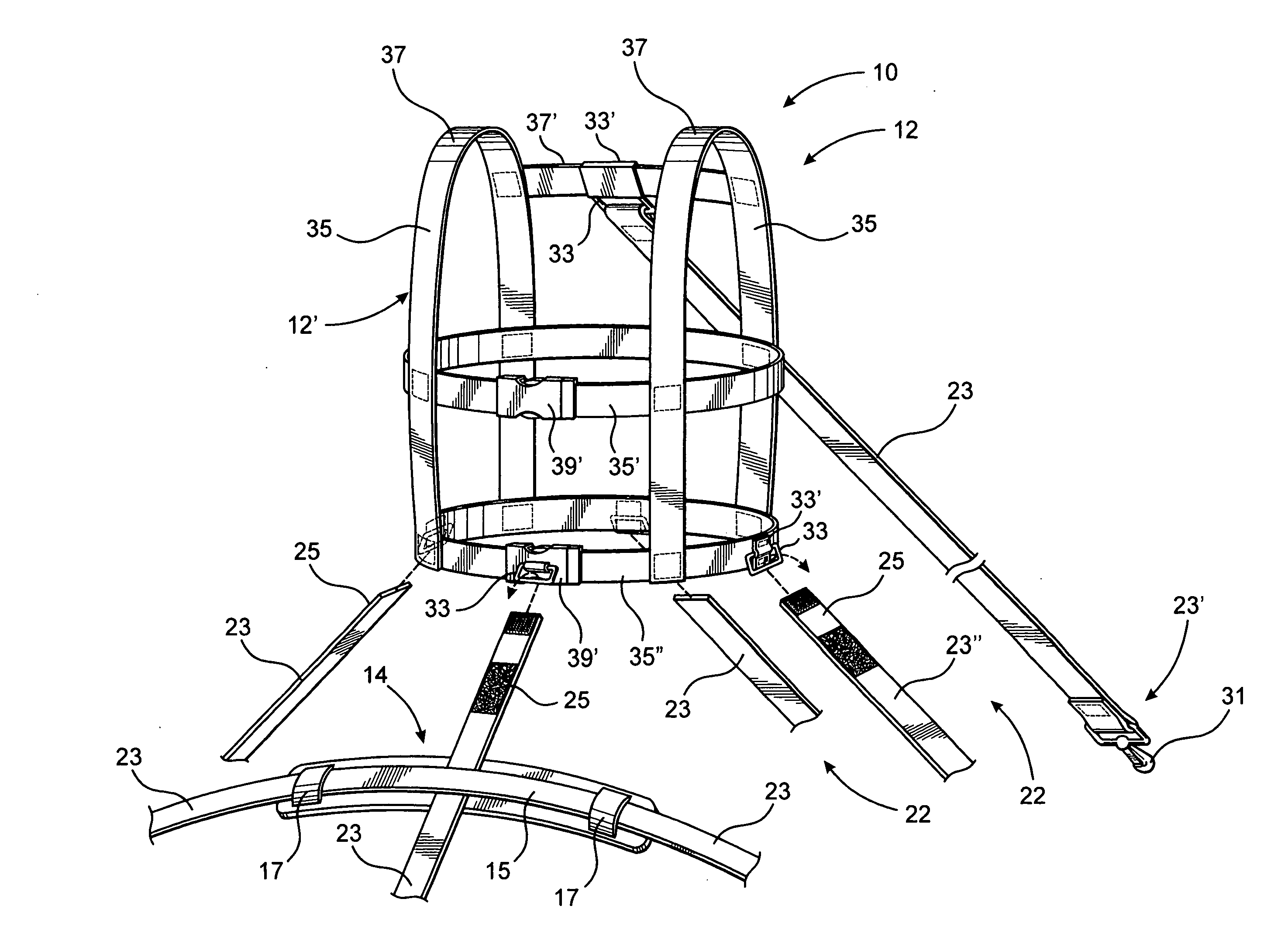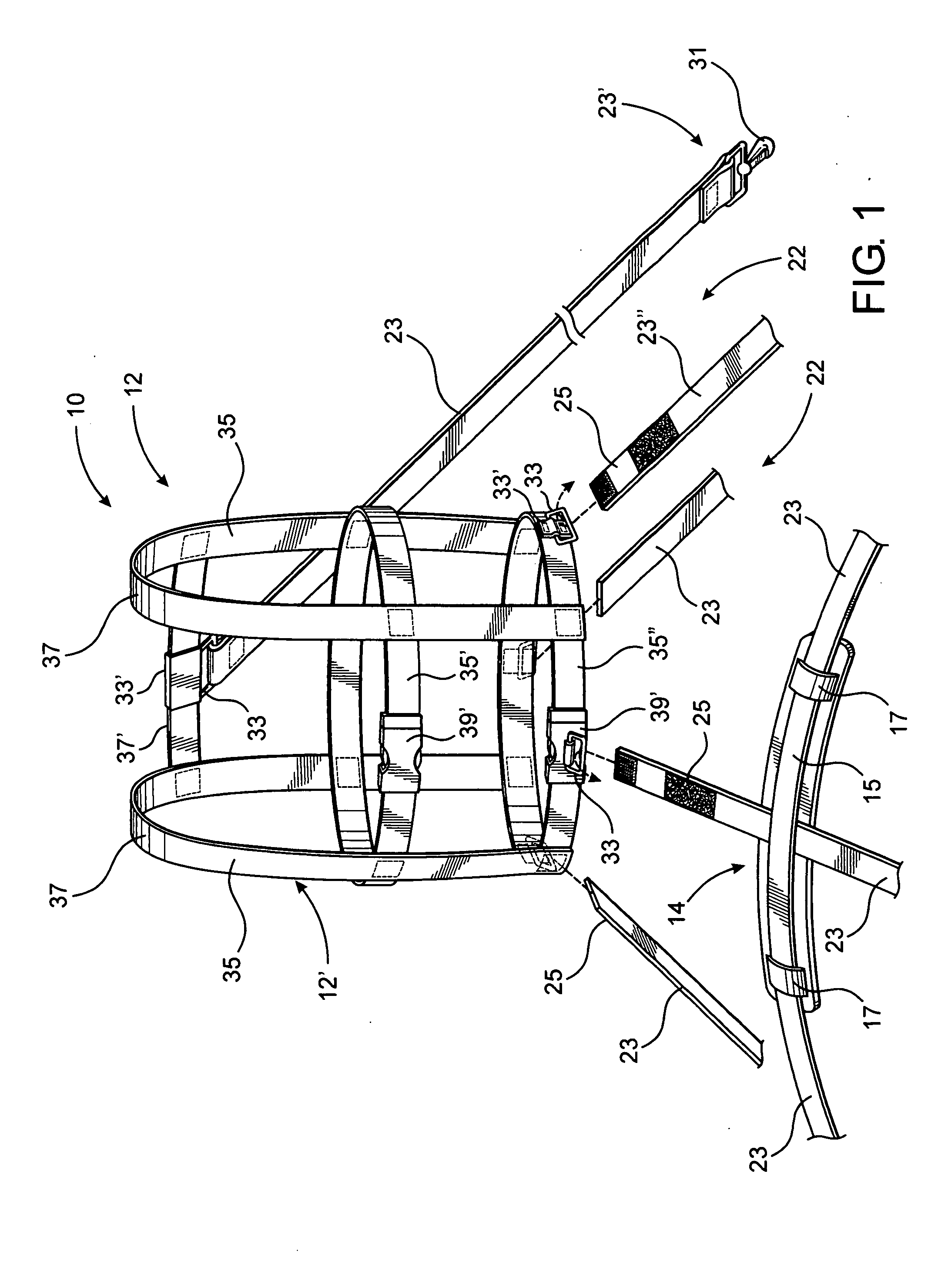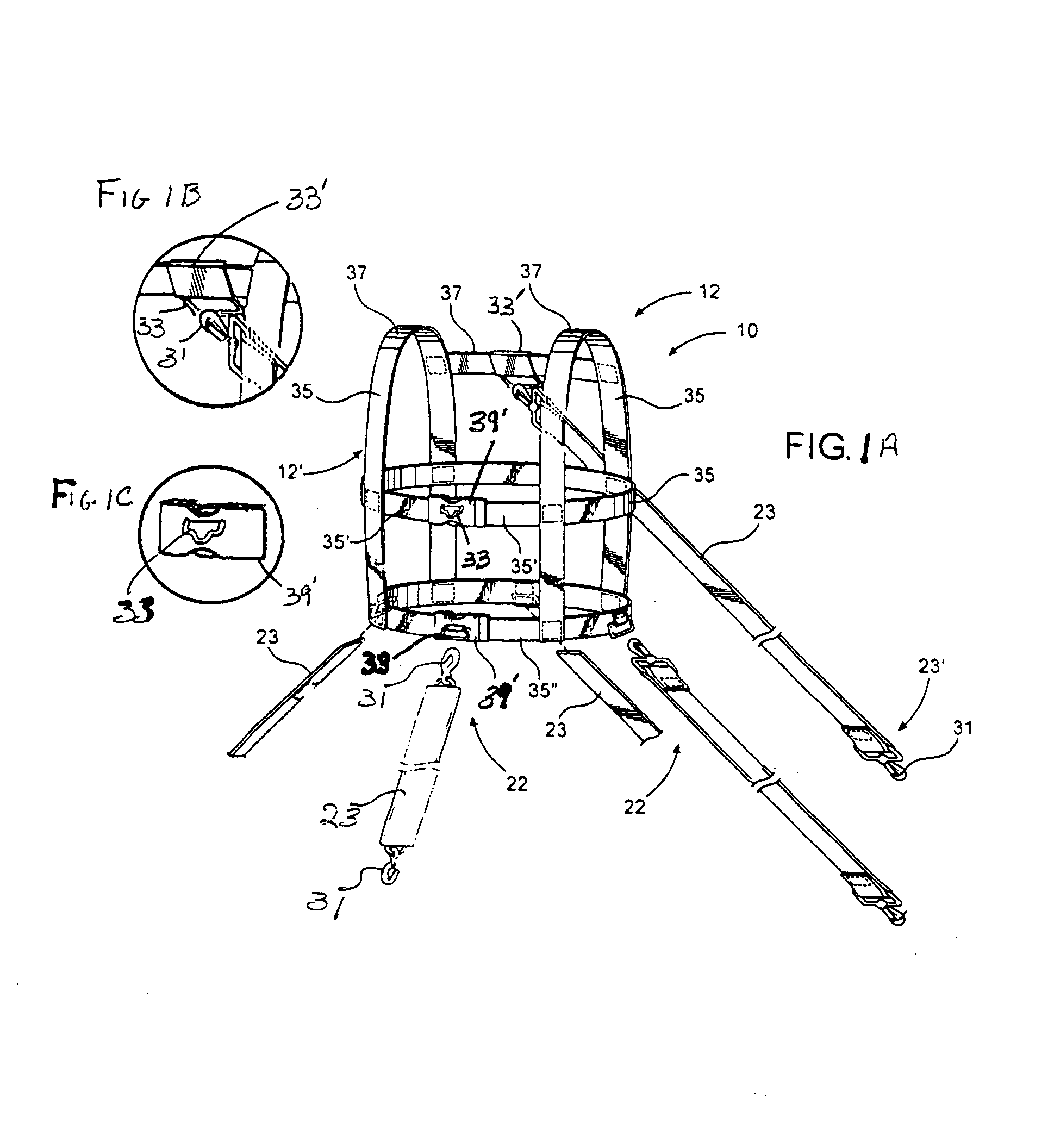[0016]Stabilization of the individual is also accomplished by a cooperative structuring and disposition of a restraint assembly and an anchor assembly both included as operative parts of the stabilization assembly. More specifically, the restraint assembly is removably and / or adjustably connected to the one or more harness structures mounted on the individual and is removably attached to the anchor assembly. In one embodiment the anchor assembly is disposed in supporting relation beneath the individual and the
wheelchair or other support structure in which the individual is seated. As such, the anchor assembly may comprise a support platform or like structure disposed and structured, by virtue of its connection with the restraint assembly, to at least partially
restrict or at least regulate movement of the predetermined portion of the user's body to which the harness assembly is attached. Accordingly, the individual is able to securely and safely maintain an intended operative position required to effectively perform a given exercise or activity. As should be apparent, the absence of proper stabilization of the body of the individual would frequently result in the inability to perform the exercise or
sports activity or the performance thereof in an improper manner. It is also to be noted that the anchor assembly could be defined by a more conventional floor, ground or other supporting
surface modified to facilitate removable connection to the aforementioned restraint assembly, rather than the aforementioned support platform. Further, the cooperative structuring of the restraining assembly and the anchor assembly is such as to “connect” the individual to the anchor assembly rather than the wheelchair, thereby significantly add the aforementioned “safety factor” to the use of the stabilizing assembly of the present invention.
[0018]Another of the plurality of harness structures may be specifically intended to overlie and cover a portion of the “lap” of the individual while in the seated position. Also, the plurality of harness structures may include a generally annular member of sufficient dimension and configuration to fit over the individual's head and / or somewhat surround the neck of the individual while being outwardly spaced there from in overlying relation to at least an inner portion of the shoulders or other
body area adjacent the neck of the individual. Further, this annular member may be dimensioned and configured to also surround and restrictively engage the
waist or hip area of the individual thereby enabling it to stabilize different portions of the individual's body dependent, as set forth above, on the exercise or activity being performed as well as a variety of other factors.
[0020]As also set forth above, a primary function of the restraint assembly is to stabilize each of the plurality of harness structures utilized by interconnecting and thereby “anchoring” the harness structure to the anchor assembly. In doing so, the harness structures and the corresponding body portions to which they are attached, will be at least partially restrained from undesirable or unsafe movement which may be caused by a resistance or reaction force being placed on that corresponding body portion during the performance of the various exercises or other physical activities. Therefore, the restraint assembly comprises a plurality of restraining members connected to the one or more harness structures being utilized and removably connected, at spaced apart locations, to the anchor assembly.
[0021]A specific location of
interconnection between the harness structure utilized and the anchor assembly is again dependent upon the dimension, configuration and structure of the harness structure being utilized and the exercise or sporting activity being performed. Therefore, the anchor assembly preferably comprises the support platform or other supporting surface or structure having a plurality of anchor members disposed in spaced apart relation thereon. Each of the anchor members is cooperatively structured with the plurality of restraining members to facilitate removable connection therebetween. Also, a spaced apart array of anchor members on the anchor assembly allows for the selective positioning of the plurality of restraining members such that an adequate and predetermined restraining or stabilizing force can be exerted on the harness structure in order to stabilize the body part to which it is attached.
[0022]As generally set forth above, at least one embodiment of the present invention comprises the anchor assembly being defined by a support platform on which the wheelchair or other support structure supporting the individual is mounted. Therefore, it should be readily apparent that the weight of the wheelchair or other support structure as well as the weight of the individual serves to render the support platform of the anchor assembly in a secured, intended position thereby allowing it to provide sufficient anchoring force to the harness assembly through
interconnection therewith by the restraining assembly.
[0023]As is appreciated by those individuals suffering from a
spinal cord injury, various portions of the individual's
torso may be more significantly affected by the location of the primary injury along the
spinal cord. By way of example only, those individuals suffering from a lower
spinal cord injury may have more extended use of the
waist area,
abdomen, chest, shoulders, arms, etc. than those individuals suffering from an injury located along the upper regions of the spinal cord. Accordingly, the different structural modification and operational features of the different harness structures are at least partially intended to engage different portions of the user's body such as, but not limited to, the
waist, chest, shoulders, arms, etc. Therefore, different embodiments of the harness assembly, defined by the various structural modifications of the different harness structures are intended to engage, be connected to or mounted on different portions of the user's body which best facilitate the orientation and posture of the individual while performing an exercise or sporting activity. Concurrently, the individual will be safely secured to the anchoring assembly, rather than the wheelchair or other support structure, thereby being able to perform adequate and intended movement of appropriate body portions used in the performance of the exercise or
physical activity.
 Login to View More
Login to View More  Login to View More
Login to View More 


